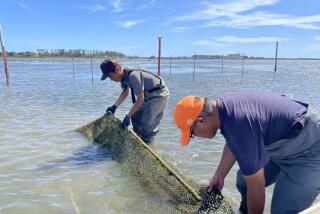THE WORLD - News from March 22, 2009
- Share via
PUERTO AYORA, GALAPAGOS ISLANDS — Fisherman Luis Enrique Bonilla just wants to make a living. Galapagos Islands conservationists, worried that the marine reserve is overfished, want him to work in tourism.
Bonilla and the local fishermen he represents say a move from commercial fishing to boat tours is an expensive and complex prospect for which they have no money or training. They have already made concessions to preserve marine species, each owning only one small boat and using simple lines and lures to catch fish by hand.
But even with the restrictions, some species in the Galapagos Marine Reserve have been decimated -- including sea cucumbers and lobster -- putting even more pressure on fishermen forced to live off smaller catches.
Bonilla’s story shows just how hard it is to protect the archipelago’s biodiversity that Charles Darwin made famous. Changing livelihoods from those that destroy the islands to those that sustain them is easier said than done.
“I want to be able to sell more fish,” Bonilla said. “Right now that’s hard to do with the way the rules are.”
The marine reserve, home to more than 3,000 species, has suffered over the years from fishermen eager to exploit local, national and international markets, park officials say.
Edwin Naula, director of tourism and a former director of Galapagos National Park, said it has been a struggle to get fishermen to comply with rules to protect the reserve.
“It’s like when you have your children in the house and everything is out of order. And of course the children get angry when the father comes home and tells them to put things in order,” he said.
Darwin first arrived in the Galapagos nearly 175 years ago, discovering the unique species that would become the basis for his theory of evolution. The spectacular subjects of his work, including finches, giant tortoises, marine iguanas and blue-footed boobies, now draw more than 150,000 tourists a year to the Pacific islands about 600 miles off the coast of Ecuador.
They were declared a UNESCO World Heritage Site in 1979 for the unique animal and plant species and added in 2007 to UNESCO’s list of sites in danger from environmental threats or overuse.
Although fishing is still the second-most lucrative industry in the Galapagos, it is far behind tourism -- bringing about $3 million to islands’ economy versus $63 million from tourism, according to the Charles Darwin Foundation and the Galapagos Institute.
Bonilla, 43, who came to the Galapagos at age 11 from mainland Ecuador, has been fishing for most of his life. He carries a license and is president of the Santa Cruz Island fishing cooperative, a group of more than 200 fishermen on the Galapagos’ major inhabited island among 22 main islands and scores of smaller ones.
Industrial fishing has been prohibited in the marine reserve since 1998. So fishermen -- at least those who fish legally -- are limited to what they can catch with artisan methods. Bonilla, whose crew at times consists of his shy 12-year-old son, Luis Jr., trolls with lures on expeditions that can last up to four days.
He fishes in a fiberglass boat named the Eagle Ray and says he has no money to invest in modern equipment that would make his work more efficient. His on-board refrigeration, for example, is an ice chest.
Cooperative members see the regulations on their industry as unnecessarily strict. But overfishing also has made it hard for them to make a living.
The sea cucumber population dropped dramatically in the last decade, said Matthias Wolff, director of marine and coastal sciences for the Charles Darwin Foundation.
Without the sea cucumber and lobster, fishermen have turned to other species, such as sharks, which are illegal to fish. Though he follows the rules, Bonilla said, most fishermen have landed illegal species at some time or another.
Park officials see an alternative business for the fishermen in tourism, either in fishing trips showing visitors their artisan methods or in day trips for snorkeling or hiking.
Bonilla said he wouldn’t be able to make money on the first option, and the second is too expensive, requiring life jackets, canopies and bathrooms, among other modifications.
The fishermen’s small boats mean they can’t carry enough passengers to make a profit that would justify the investment, he added. And most fishermen speak only Spanish.
The park has been promising tourism licenses exclusively for members of the fishing cooperatives since 2001, but they have been bogged down in bureaucracy and disputes over how the licenses would be granted.
Even for those who can get licenses, it’s expensive to launch even a small tourist operation. The environmental impact study alone can cost up to $15,000, Bonilla said, more than the $9,000 to $14,000 fishermen make in a year.
More to Read
Sign up for Essential California
The most important California stories and recommendations in your inbox every morning.
You may occasionally receive promotional content from the Los Angeles Times.










